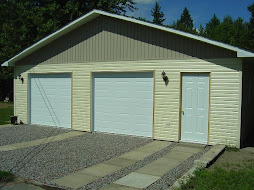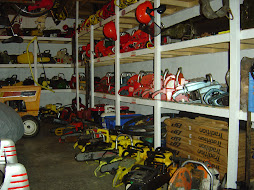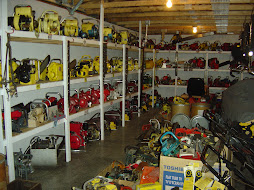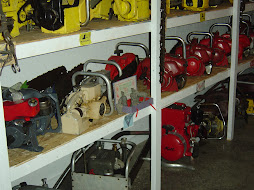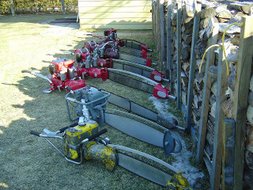



RESTORATION IN PROGRESS...........
A bit of History:
Taken from "Working in the Woods"

Bloedel, Stewart and Welch, Camp 5
Art Backlund, Camp 5 mechanic, Dick Burnett (manufacturer of Burnett Chainsaws), and camp foreman Martin Fossum with a new two-man Burnett chainsaw.
This part of the story begins in 1920, when George Challenger worked in Lough Borough as managing director of Grassy Bay Timber, a short-lived railway logging company owned by Dewey and Clay Anderson. In 1922, George decided to start his own logging company in Beaver Inlet Camp. This came to an end when, in 1925, a steam donkey caught fire and burned out the claim. Jump to 1936. Jack Challenger, son to George, is working for Bloedel Stewart Welch "BS&W" as a faller (tree faller) and bucker (log roller) supervisor. In 1937, Jack is placed in charge of acquiring and field-testing new saw technology for BS&W. In 1940, machinist Bob Shade was sent to Germany to work with Andreas Stihl on improvements to their saw based on Jack's field testing. In 1941, after returning from Germany, Shade starts "Shade Engineering". This is done with backing from BS&W. Prentice Bloedel and Jack Challenger were directors. Shade made a power saw using a Villiers motorcycle engine sold by Canadian motorcycle wizard, Fred Deely. When a dispute between Shade and BS&W arose, Challenger and Bloedel sold their shares to Fred Deely, who, in, turn, sold out to Dick Burnett. This was in 1944; three months later, Burnett fired Shade, who had been called off to war. Dick Burnett then began working with Challenger, and the BS&W crew was in full swing by 1945. In 1946, Don Challenger?s nephew, Jack, set up "Power Saw Sales and Service" in Vancouver. It is from this time, 1946 to 1949, that Burnett experienced an all-too-brief period of success. Also at this time, Bob Swanson contacted DickBurnett. It is Burnett?s machinist he needs, and, as a sideline effort, Burnett starts turning out the now-famous H-series Swanson locomotive air chimes. By 1950, however, Burnett was little more than a distributor for Homelite and McCulloch. In 1954, Ernie Cannon, who had started with Shade Engineering, later with Burnett Engineering, starts his own power saw component company, "Cannon Machine works" of Vancouver. As a sideline, Cannon also agrees to take over all machine work for Bob Swanson?s horns, and soon moves his company to Burnaby. As sales grow, the company becomes Airchime, Ltd. Ernie recounted to us his early days, noting that, in his opinion, Dick Burnett was more of a promoter than developer or businessman. Cannon complained constantly about the lack of good equipment Burnett was furnishing for him to use. "They wanted us to turn out well- machined motors and bars for the saws using old World War II lathes and milling machines. We never could get Dick to reinvest in the company." Later, Burnett, following bankruptcy, went into the stock market as a promoter and seemed to find his niche. When the bankers came to sell off his machine shop, Ernie was keen to get some of the machine tools. Most of the specialty tools Ernie had fabricated himself, and he wasn't about to let those get loose. With the remnants of Burnett Power Saw & Engineering now in possession of Cannon Machine Works, Ernie was making a name for "Cannon" in the chainsaw community and also turning out air whistles for Bob. Unlike Burnett, though, he never attached his namesake to these early horns. In the coming years, the Swanson whistles would have the names NATHAN (Airchime?s US affiliate for locomotive horns) and AIRCHIME clearly shown, but it was CANNON that was their manufacturer. Another name that appears at this time is Bill Piercy. Like Cannon, Piercy, had come from Burnett Engineering, and now was working for Swanson as a mechanical design engineer of new whistles. Also, at this time, it should be noted that AIRCHIME and CANNON MACHINE WORKS were two separate entities working under the same roof in Burnaby. Cannon had created two companies, Cannon Machine Works and Cannon Holdings. Bob bought ten percent in each company, and, as Ernie tells us, ?This way Bob could bring people from all over to see his shop?. This relationship continued until sometime in the 1970?s.
MANUFACTURED BY: BURNETT POWER SAWS & ENGINEERING CO. LTD. VANCOUVER, BRITISH COLUMBIA, CANADA SERIES OR ASSEMBLY NUMBER: YEAR INTRODUCED: 1946 YEAR DISCONTINUED: ENGINE DISPLACEMENT: 125cc (7.62 cu. in.) NUMBER OF CYLINDERS: 1 CYLINDER BORE: 50 mm (1.96 in.) PISTON STROKE: 62 mm (2.44 in.) CYLINDER TYPE: Cast Iron INTAKE METHOD: Piston ported MANUFACTURER ADVERTISED H.P.: WEIGHT: 75 lbs. with 48 in. bar, chain & tailstock 34 kg with 122 cm bar, chain & tailstock OPERATOR CONFIGURATION: Two Man operation HANDLEBAR SYSTEM: Rigid CHAIN BRAKE: none CLUTCH: Multiple dry asbestos disk, manual control DRIVE TYPE: Bevel gear transmission CONSTRUCTION: Sand cast aluminum MAGNETO TYPE: Villiers flywheel type CARBURETOR: Villiers float type MAJOR REPAIR KIT: MINOR REPAIR KIT: AIR FILTER SYSTEM: Wire screen STARTER TYPE: Rope OIL PUMP: Manual and gravity feed MAXIMUM ENGINE RPM: 3,850 to 7,000 IDLE RPM: IGNITION TIMING: Lock flywheel so points break 3/8 in. before TDC BREAKER POINT SETTING: see above FLYWHEEL/COIL AIR GAP: fixed SPARK PLUG TYPE: SPARK PLUG GAP: 0.018 in (0.45 mm) CRANKSHAFT MAIN BEARINGS: Ball and Roller types FUEL TANK CAPACITY: FUEL OIL RATIO: 12:1 RECOMMENDED FUEL OCTANE: Regular MIX OIL SPECIFICATION: SAE 40 CHAIN PITCH: .750 in. (19 mm) CHAIN TYPE: Burnett Scratcher BAR MOUNT PATTERN: SHORTEST GUIDE BAR SUPPLIED: 36 in. (91cm) LONGEST GUIDE BAR SUPPLIED: COLOUR SCHEME: Unpainted aluminum castings, Black enamel tank and handlebars



